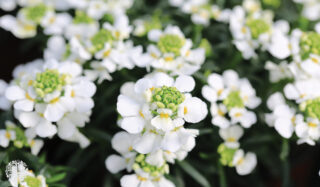Spring has sprung, and the garden’s candytuft is in full bloom. The gorgeous plant drapes itself over the edge of the rock wall; its pure white blossoms stand out against the foliage of other plants that have yet to open and attract pollinators in search of early-season food. Providing bees, butterflies, and other insects with enough nectar is essential, and candytuft is an excellent way to welcome them before summer begins.
Part of the Brassicaceae family, candytuft (Iberis sempervirens) is a spreading, woody-based, herbaceous perennial or sub-shrub. Springtime candytuft typically forms a mound of dark green inch-long leathery leaves. An evergreen in my zone 7 garden, in colder climates, the foliage can become straggly and leaves drop. No worries; they will all come back bigger and better. The plant produces tiny white four-petalled flowers in dense, flattened clusters (corymbs) in spring.
There are several different candytuft varieties. Alexander’s White is about a foot wide and has more flowers than other varieties, such as Little Gem and Purity. Both are more compact, with a spread of approximately 6-8”. Whether the desired effect is a flowing waterfall of white over the rock wall or a smaller plant trailing out a container, candytuft is happy to oblige.

General Care
Hardy to Zone 3, Alexander’s White (in my garden) loves full sun and loamy, well-draining soil. It prefers to be kept moist, not too dry or too wet.
Candytuft will bloom in part shade but less prolifically than in full sun. Once it flowers, cut or sheer the stems back about a third to encourage new growth and maintain its compact habit. Although it may feel like you’re cutting back the entire plant, if you don’t prune it well, it won’t bloom as beautifully as it should in the spring.
Problems
Candytuft is susceptible to root rot. If planting in a container, ensure the pot has good drainage. Slugs, snails, and caterpillars are a problem for the plant, but they have not bothered mine for some reason. Powdery mildew and leaf spot are also common issues. The best way to keep these diseases at bay is to ensure the plant gets water through its roots and never via the leaves. Doing so prevents the disease spores from growing.
Without candytuft, my April garden would be bare. It stands out as a plant of distinction, earning its place as a favorite, easy-to-grow garden perennial.
Join me next month as we garden and grow together.